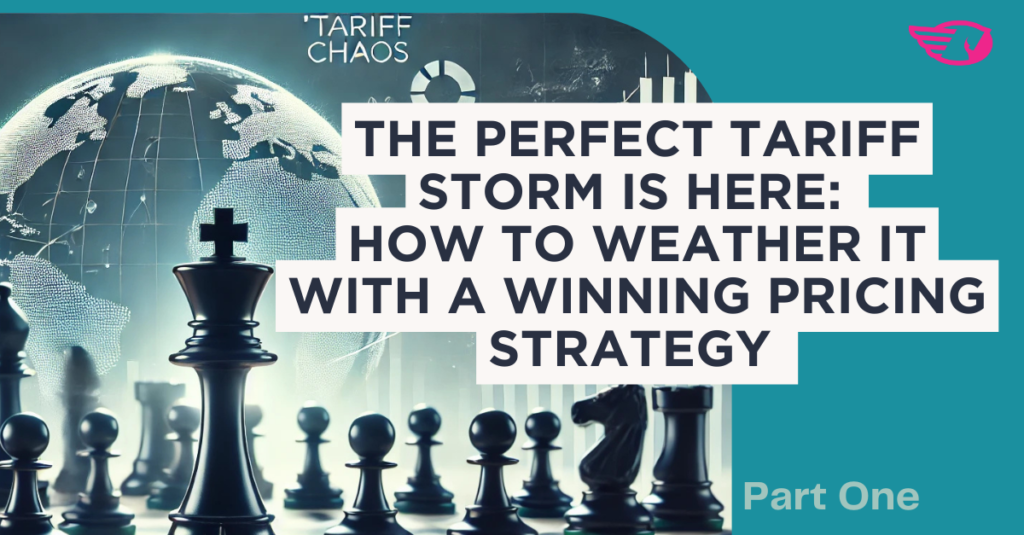
Tariffs as Opportunity: Building Pricing Power
Tariffs disrupt global trade, drive up costs, and force businesses to rethink pricing strategies. But while some companies struggle to keep up, smart businesses treat pricing as a strategic asset- leveraging it to understand customer perceived value and strengthen pricing power, rather than simply a reactionary tool to shifting market conditions.
As pricing expert Prof. Hermann Simon puts it: “Price is not a mere figure; it is a reflection of perceived value.”
So how do businesses build durable pricing strategies to navigate uncertainty while maintaining profitability and customer trust? Three key strategies stand out:
Scenario-Based Pricing: Stay agile with a flexible, data-driven approach to absorb small tariff shifts while maintaining price stability.
Value-Based Pricing: Shift the focus from cost to customer value, leveraging differentiation and bundling strategies to justify price points.
Transparent Communication: Build trust by being upfront about the “why” behind pricing adjustments and reinforcing the added value customers receive.
The Bottom Line: The strongest brands don’t wait for stability—they plan for uncertainty. Companies that leverage agile pricing, value-driven differentiation, and transparent communication will leverage tariffs as an opportunity to cement existing customer relationships and build loyalty among new ones.
At ZELOCIN & Partners, we turn pricing strategy into a competitive advantage—helping businesses navigate fast-changing market environments, optimize profitability, and build customer loyalty.
Blog:
Tariffs are shifting, and the cost of doing business is rising fast. One policy change can squeeze your margins, disrupt supply chains, and force you into tough pricing decisions.
But smart businesses don’t just react—they turn pricing strategy into a competitive advantage. The real game isn’t just about adjusting prices; it’s about understanding customer value, leveraging pricing power, and staying ahead without getting tangled up in a pricing war and getting everyone caught in a downward spiral.
As Hermann Simon, the preeminent authority on pricing, articulates: “Price is not a mere figure; it is a reflection of perceived value.” Companies that harmonize pricing with customer expectations, innovation, and differentiation don’t just weather volatility; they dominate.
3 Strategies to Strengthen Customer Relationships & Enhance Strategic Positioning in a Tariff-Impacted Market:
1. Scenario-Based Pricing—Stay Agile, Stay Ready:
Why it works: Market leaders don’t wait—they prepare. Tariff fluctuations demand a flexible, data-driven approach that lets you pivot before customers feel the impact.
Consider this: During tariff increases, the rising costs of raw materials, components, and finished products can lead to reduced market availability as businesses seek to avoid uncompetitive cost structures. This supply limitation drives up demand, tempting remaining competitors in the industry to offset costs by raising prices. However, excessive price increases can erode customer lifetime value, as higher prices may lead to lower retention and increased churn rates.
How to implement it:
- Baseline Price: No major tariff increases.
- Moderate Adjustment: Absorbs small tariff shifts while keeping pricing stable.
- Strategic Increase: If tariffs spike, introduce tiered pricing or adjust product configurations to maintain margins without shocking customers.
ZELOCIN INSIGHT: Rather than blindly following market trends, visionary companies build resilience through strategic foresight. Businesses with strong access to data can leverage predictive analytics to anticipate cost fluctuations and adjust pricing proactively. In times of uncertainty, customer data serves as a crucial anchor, helping companies identify the perceived value of their offerings and develop strategies to maximize it. This not only prevents margin compression but also strengthens differentiation and deepens your understanding consumers’ willingness to pay—turning pricing strategy into a powerful competitive advantage.
2. Value-Based Pricing—Compete on Value, Not Just Cost:
Why it works: Companies that compete on price alone are at the mercy of tariffs. The smartest brands justify their pricing by emphasizing quality, differentiation, and customer experience.
How to implement it:
- Shift the focus from cost to value: Customers don’t pay for what something costs—they pay for the benefit it provides.
- Move beyond commodity pricing: Make sure customers see why your product is worth the investment, even at a higher price point.
- Leverage subscriptions & bundling: Instead of pushing one-off sales, lock in long-term relationships that stabilize revenue and soften tariff impact.
ZELOCIN INSIGHT: “While the temptation to capitalize on tariff-induced cost increases through overpricing may be strong, prioritize customer retention over short-term gains. Remember, acquiring a new customer can cost five to seven times more than retaining an existing one. Strategic pricing should focus on maintaining perceived value and fostering long-term loyalty, even if it means absorbing some cost increases. Excessive overpricing risks alienating customers, damaging brand reputation, and ultimately costing more in lost future revenue.”
3. Transparent Communication—Build Trust, Not Backlash
Why it works: Customers don’t hate price increases – they hate unexpected price increases. If they understand why, they’re more likely to stay loyal.
How to implement it:
- Be upfront about tariff-related adjustments: frame them around added value, service improvements, or enhanced reliability.
- Break down the costs: showing Revised: Being transparent about exactly where the money goes builds credibility.
- Offer pre-tariff pricing incentives: letting customers lock in lower prices before increases hit encourages early adoption.
Pricing in Action: MARK VII Equipment Inc., a manufacturer of car washing equipment and the dominant player in its respected industry, successfully imposes small, frequent price increases while maintaining a strong, loyal customer base. MARK VII pulls off this winning pricing strategy by pairing it with sincere transparency. Openly communicating the “why” behind price increases has empowered MARK VII to build trust and strengthen customer relationships while preserving perceived value and boosting brand equity.
ZELOCIN INSIGHT: Transparency is crucial to combat price gouging accusations. When communicating tariff-related increases, provide a data-driven narrative explaining the specific cost impacts and supply chain realities. This demonstrates a thoughtful response to external pressures, mitigating backlash and reinforcing your brand’s commitment to honesty, ultimately strengthening customer trust and loyalty.
The Bottom Line: Pricing Is Your Power Move
The strongest brands don’t wait for stability – they plan for uncertainty. The businesses that leverage agile pricing, value-driven differentiation, and transparent communication won’t just survive tariffs—they’ll use them to cement existing customer relationships and build loyalty among new ones.
